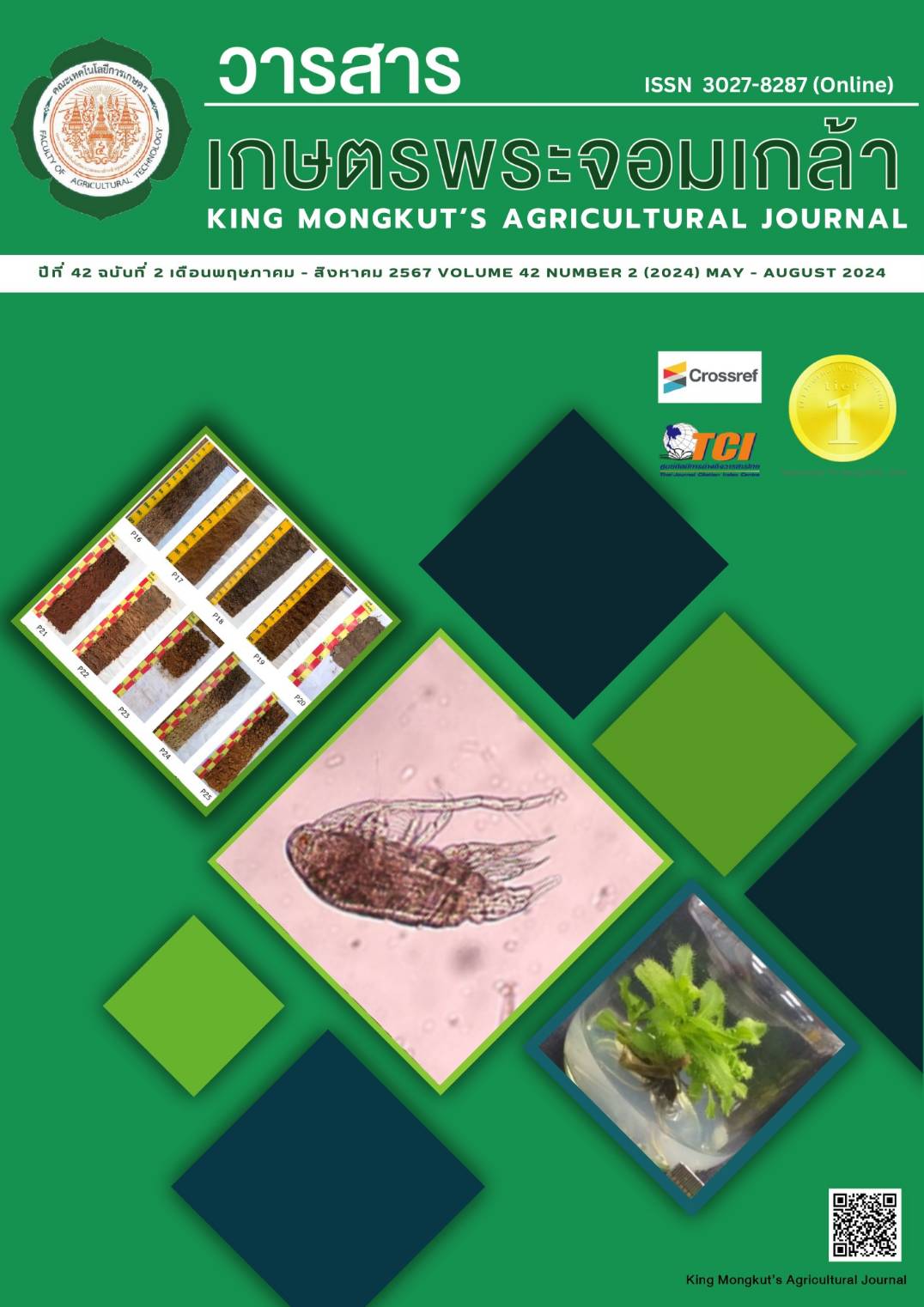ผลของความเข้มข้นและความถี่ของรำข้าวเปลือกหมักต่อการเพิ่มจำนวนของโคพีพอดธรรมชาติ
Main Article Content
บทคัดย่อ
การผลิตโคพีพอดธรรมชาติ โดยการให้รำข้าวเปลือกหมักเป็นอาหาร ที่ความเข้มข้นต่างกัน 3 ระดับ 50, 100, 150 ppm และความถี่ของการให้อาหารต่างกัน 2 ระดับ คือ ให้ครั้งเดียวและให้สองครั้ง (ในวันที่ 4) ต่อการเพิ่มจำนวนและองค์ประกอบของโคพีพอดในธรรมชาติ โดยวางแผนการทดลองแบบแฟคทอเรียล (Factorial design) ในถังพลาสติกขนาด 10 ลิตร 18 ใบ เป็นเวลา 30 วัน ผลการทดลองพบว่าโคพีพอดมีการตอบสนอง (เพิ่มและลดจำนวน) ไปในทิศทางเดียวกัน ปัจจัยทั้งสองมีอิทธิพลร่วมกันต่อการเพิ่มจำนวนของโคพีพอด (p<0.05) โดยความหนาแน่นโคพีพอดพบสูงสุดในการทดลองที่ให้อาหารเพียงครั้งเดียวตลอดการทดลองที่ความเข้มข้น 150 ppm (ค่าเฉลี่ย±SE) 6.4±1.4 ตัว/ มล. ขณะที่การให้อาหารเพิ่มขึ้นเป็นสองครั้ง (วันที่ 4) ที่ความเข้มข้นของรำข้าวเปลือกหมักต่ำไม่มีผลต่อความหนาแน่นของโคพีพอด (p>0.05) มีค่าเฉลี่ย (±SE) สูงสุด 2.7±0.4, 2.4±0.3, 2.1±0.5 ตัว/ มล.ตามลำดับ สำหรับกลุ่มชนิดของโคพีพอดที่พบมากที่สุดคือ คาลานอยด์ ไซโคลพอยด์ ฮาร์แพคทิคอยด์ (ร้อยละ 64.9, 23.3, 11.8) และสัดส่วนร้อยละของระยะการเติบโตที่พบมากสุดคือ นอเพลียส ตัวเต็มวัย โคพีโพดิด และตัวเต็มวัยที่มีถุงไข่ (38.9±2.0, 37.0±1.7, 23.6±1.4, 0.5±0.2.) ตามลำดับ ผลการทดลองสรุปได้ว่าการให้รำข้าวเปลือกหมัก ที่ความเข้มข้นสูง 150 ppm เพียงครั้งเดียว เพียงพอสำหรับการเพิ่มจำนวนโคพีพอดธรรมชาติจำนวนมากได้
Article Details

อนุญาตภายใต้เงื่อนไข Creative Commons Attribution-NonCommercial-NoDerivatives 4.0 International License.
วารสารเกษตรพระจอมเกล้า
เอกสารอ้างอิง
Aquamimicry. (2014). Protocol for an Extensive Aqua Mimicry Aquaculture: Natural Synbiotics Management ‘Extensive Culture). Retrieved from: https://baxelcompany.com
Chakravarty, S., Kumar, S., & Prakash, S. (2018). Back to the Basics: Biomimicry in Shrimp Farming. International Journal of Current Microbiology and Applied Sciences, 7(5), 2172-2184. https://doi.org/10.20546/ijcmas.2018.705.253.
De, Tailly. J-B. D. (2019). Study of an economical shrimp farming protocol aiming at improving control over water quality. Skretting a Nutreco Company. Retrieved from: http://creativecommons.org/licenses/by-nc-nd/4.0/deed.fr
Jepsen, M. P., Christina, V. T., Thibaut, Carron-Cabaret., Aleix, Pinyol-Gallemí., Søren, L. N., & Benni, W. H. (2018). Effects of salinity, commercial salts, and water type on cultivation of the Cryptophyte Microalgae Rhodomonas salina and the Calanoid Copepod Acartia tonsa. Journal of the World Aquaculture Society, 50(1), 104-118.
https://doi.org/10.1111/jwas.12508
Magouz, F. I., Essa, M. A., Matter, M., Tageldein Mansour, A., Alkafafy, M., & Ashour, M. (2021). Population Dynamics, Fecundity and Fatty Acid Composition of Oithona nana (Cyclopoida, Copepoda), Fed on Different Diets. Animals an Open Access Journal from MDPI, 11(5), 1188. https://doi.org/10.3390/ani11051188
Mubarak, A. S., Jusadi, D., Junior, M. Z., & Suprayudi, M. A. (2017). The population growth and the nutritional status of Moina macrocopa feed with rice bran and cassava bran suspensions. Journal Akuakultur Indonesia, 16(2), 223–233.
Nisar, U., Peng, D., Mu, Y., & Sun, Y. (2022). A Solution for sustainable utilization of aquaculture waste: a comprehensive review of biofloc technology and aquamimicry. Frontiers in Nutrition, 8, 791738. https://doi.org/10.3389/fnut.2021.791738
Romano, N., & Kumar, V. (2017). Vegetarian shrimp: Pellet-free shrimp farming. World Aquaculture, 48(4), 36-39.
Santhosh, B., Anil, M. K., Anzeer, F. M., Aneesh, K. S., Abraham, M. V., Gopakumar, G., George, R. M., Gopalakrishnan, A., & Unnikrishnan, C. K. (2018). Culture Techniques of Marine Copepods. ICAR-Central Marine Fisheries Research Institute, Kochi Kerala India.


